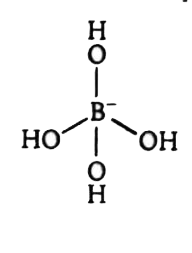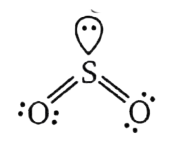Column-I and Column-II contains four entries each. Entries of Column -I are to be matched with some entries of Column-II. One or more than one entries of Column-I may have the matching with the same entries of Column-II.

The correct Answer is:A, B, C, D
(a)3I2→I+3+I−3

(b) B(OH)3+OH−→B(OH)−4
 → hybridization of B: sp3
→ hybridization of B: sp3
→ Non-polar
(c) BA2+SO2−4 
Hyrbridization of S, sp3
Non-polar
pπ−dπ bonds =2
(d)MgO⇒SO2 : covalent
 Hybridization of S,sp2
Hybridization of S,sp2
Planar
pπ−dπ bonds =1
Topper's Solved these Questions
- CHEMICAL BONDING (ADVANCED)BOOK - VK JAISWAL ENGLISHCHAPTER - CHEMICAL BONDING (ADVANCED)EXERCISE - ASSERTION-REASON TYPE QUESTIONS
57 Videos
- CHEMICAL BONDING (ADVANCED)BOOK - VK JAISWAL ENGLISHCHAPTER - CHEMICAL BONDING (ADVANCED)EXERCISE - SUBJECTIVE PROBLEMS
64 Videos
- CHEMICAL BONDING (ADVANCED)BOOK - VK JAISWAL ENGLISHCHAPTER - CHEMICAL BONDING (ADVANCED)EXERCISE - ONE OR MORE ANSWER IS/ARE CORRECT
78 Videos
- CHEMICAL BONDING (BASIC)BOOK - VK JAISWAL ENGLISHCHAPTER - CHEMICAL BONDING (BASIC)EXERCISE - SUBJECTIVE PROBLEMS
54 Videos
Similar Questions
Column-I and Column-II contains fore enteries each. Entries of Column-I are to be matched with, some entries of Column-II One or more than one entries of Column-I may have the mathching with the same entries of Column-II

View SolutionColumn-I and Column-II contains four entries each. Entries of Column-I are to be matched with some entries of Column-II. Each entry of Column-I may have the matching with one or more than one entries of Column-II

View SolutionColumn-I and Column-II contains four entries each. Entries of Column-I are to be matched with some entries of Column-II. Each entry of Column-I may have the matching with one or more than one entries of Column-II

View SolutionColumn-I and Column-II contains four entries each. Entries of Column-I are to be matched with some entries of Column-II. Each entry of Column-I may have the matching with one or more than one entries of Column-II

View SolutionColumn-I and Column-II contains four entries each. Entries of Column-I are to be matched with some entries of Column-II. Each entry of Column-I may have the matching with one or more than one entries of Column-II

View SolutionColumn-I and Column-II contains four entries each. Entries of column-I are to be matched with some entries of column-II. Each entry of column-I may have the matching with one or more than one entries of column-II.

View SolutionColumn-I and Column-II contains four entries each. Entries of column-I are to be matched with some entries of column-II. Each entry of column-I may have the matching with one or more than one entries of column-II.

View SolutionColumn-I and Column-II contains four entries each. Entries of column-I are to be matched with some entries of column-II. Each entry of column-I may have the matching with one or more than one entries of column-II.

View SolutionColumn-I and Column-II contains four entries each. Entries of column-I are to be matched with some entries of column-II. Each entry of column-I may have the matching with one or more than one entries of column-II.

View SolutionColumn-I and Column-II contains four entries each. Entries of column-I are to be matched with some entries of column-II. Each entry of column-I may have the matching with one or more than one entries of column-II.

View Solution
